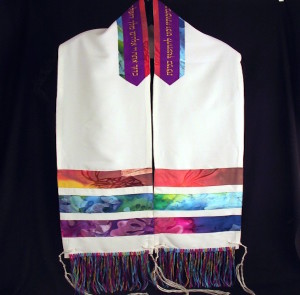Women & Tallit: Taking the Plunge
My Personal Journey to Donning, and Loving, My Prayer Shawl By Karen Akst SchecterAs a woman of a certain generation, the journey to wearing a tallit was an emotionally turbulent one. So much of the decision was fraught with emotional baggage, and it took years to shed the misplaced emotions, to marry the intellect with the heart.
Growing up, we were a traditional Jewish family with a varied level of observance: our home was kosher; we were not. I stayed home from school on all the holidays; we went shopping on Saturday afternoon. But we did belong to an Orthodox congregation, mostly because of its wonderful Rabbi. Being called to the Torah as a bat mitzvah was out of the question; in fact, even in conservative and reform congregations, a girl’s coming of age was generally celebrated on a Friday night without an aliya. My mother barely stepped foot in the shul and imparted to me her aversion to the mechitza and the role assigned to women in that shul, yet I would still go to hear the Rabbi deliver his powerful, moving, and impactful sermons. And, of course, when I was there, I would see only men in tallit.
Fast forward to my married self, a member of a conservative congregation as the egalitarian movement took hold. Women were being called to the Torah, girls were being called to the Torah as a bat mitzvah and preparing in the same way as the boys, and women were being encouraged to wear prayer shawls. And yet, feminist that I was in all other aspects of my life, mother of a daughter, intellectually averse to the rules and customs regarding women in the Orthodox world, I could not bring myself to wear a tallit.
Why not? Intellectually, wearing a tallit was a no-brainer. I embraced the egalitarian movement. There are of course many scholarly articles on whether and why women should wear tallitot, written by people across the denominational spectrum (links at the end of this blog), and many egalitarian reform and conservative synagogues expect women to wear tallit. It is said that Rashi’s daughters and King Saul’s daughter Michal all wore tzitzit, and many argue that wearing a tallit is the appropriate way to dress to ascend the bimah.
And yet, that emotional baggage remained: Men wore those great big prayer shawls, and sat in the front of the shul. Women could daven and learn, but women in my mind – or perhaps it is more accurate to say, in my heart – did not wear tallitot.
And then my children asked me one time too many why I didn’t wear a tallit, and I ran out of excuses and rational answers. It was time to delve deep into my heart, to shed those last vestiges of patriarchal Judaism, to let my heart finally catch up to my mind.
And so I took my husband’s bar mitzvah tallit, and, with shaking hands, said the blessing and put it on. To this day, what happened next continues to overwhelm me and to fill me with all of the emotion I need to wipe out the baggage: Wearing that shawl around me connected me in an intimate way to the people who, wrapped in their own prayer shawls, were praying next to me, and, at the same time, allowed me to carve out my personal space in which to daven and to connect to the Shechina, the feminine spirit of the Almighty.
Or, as it was put by another woman of a certain age, a Torah reader and synagogue leader who just donned her first tallit: “I’m finding it rather unexpectedly awesome.”
Tallitot: Rather Good for the Soul.
Some interesting articles about women and tallit: from the Chabad to the Orthodox to the Women of the Wall to the unaffiliated.







